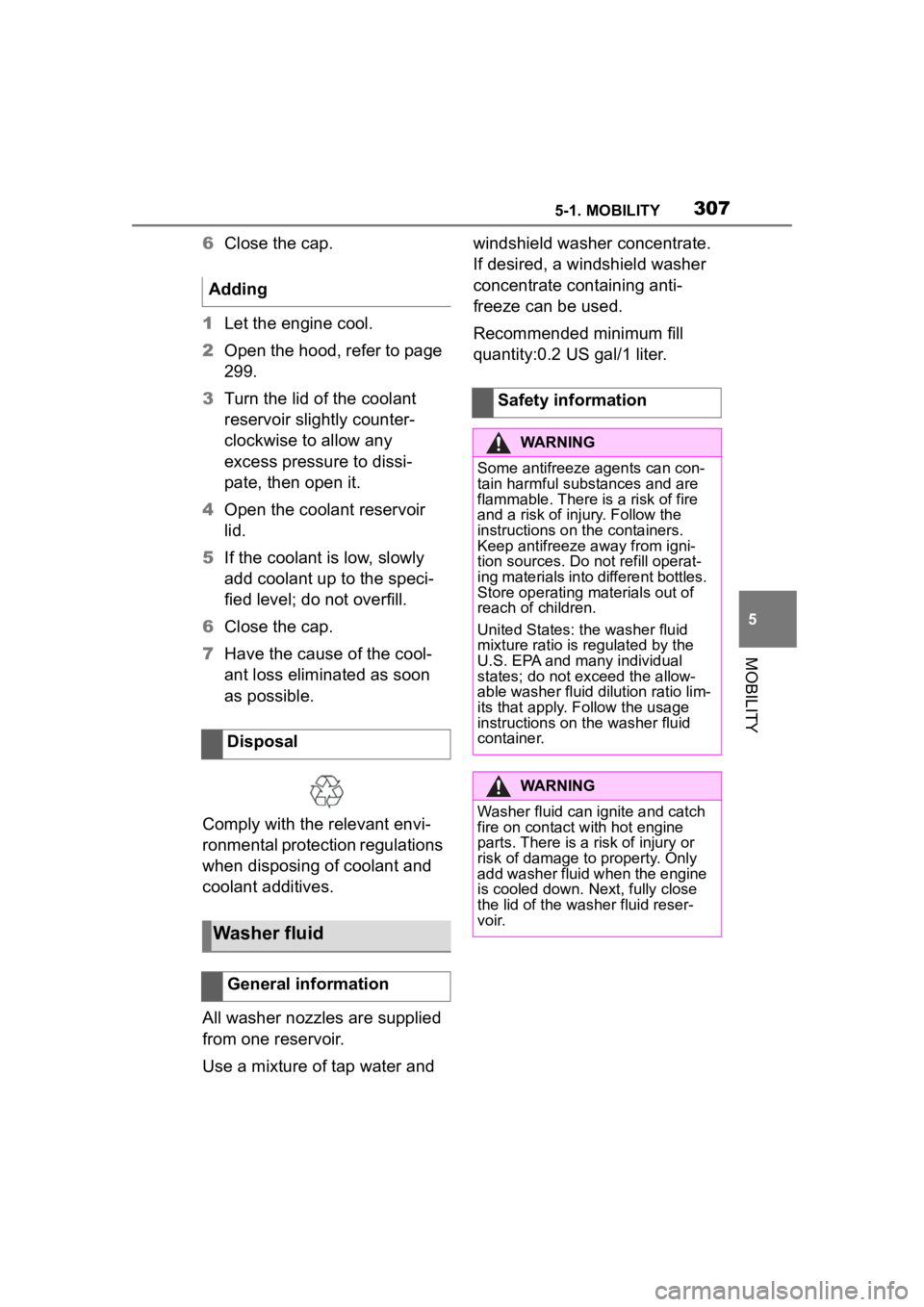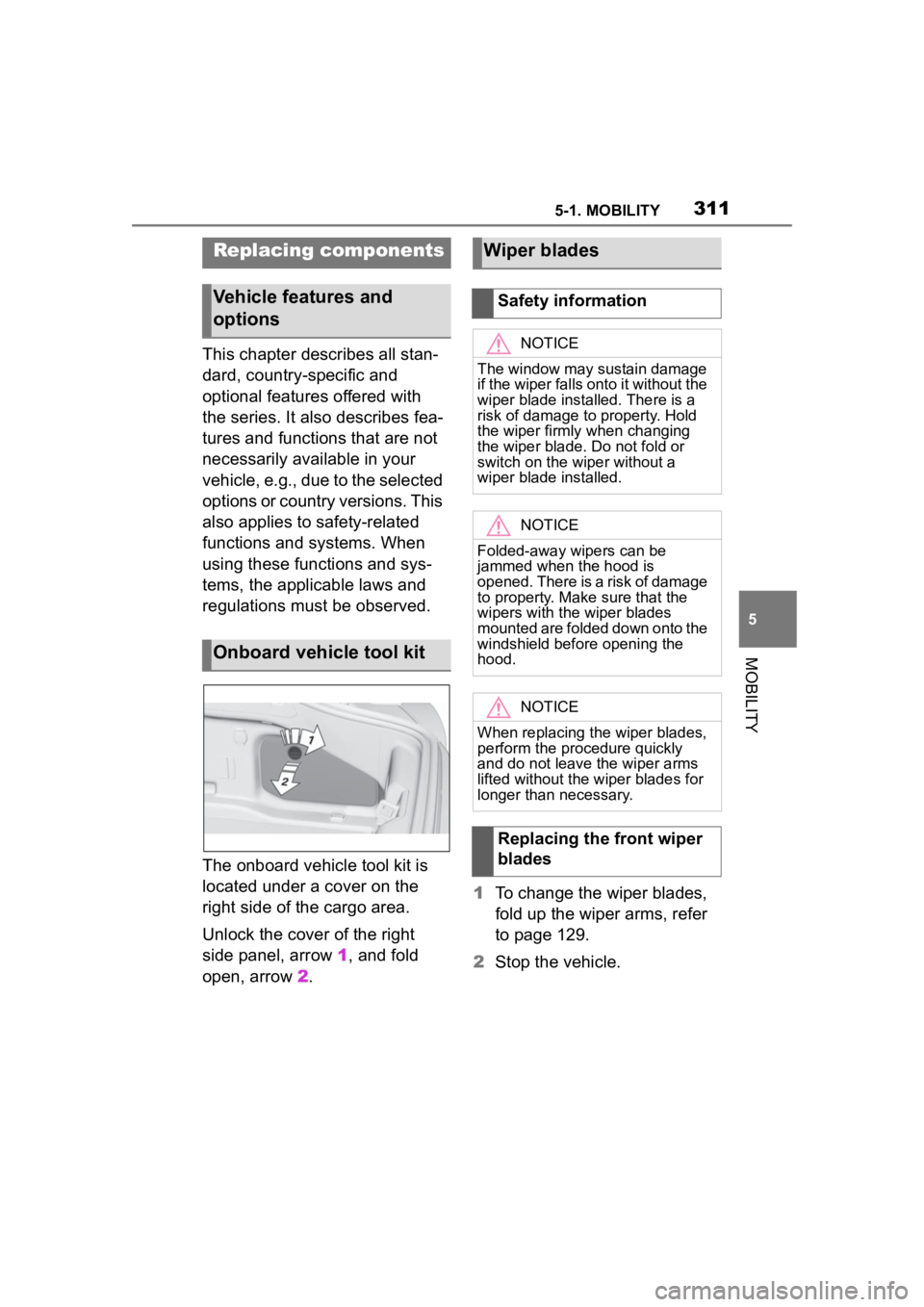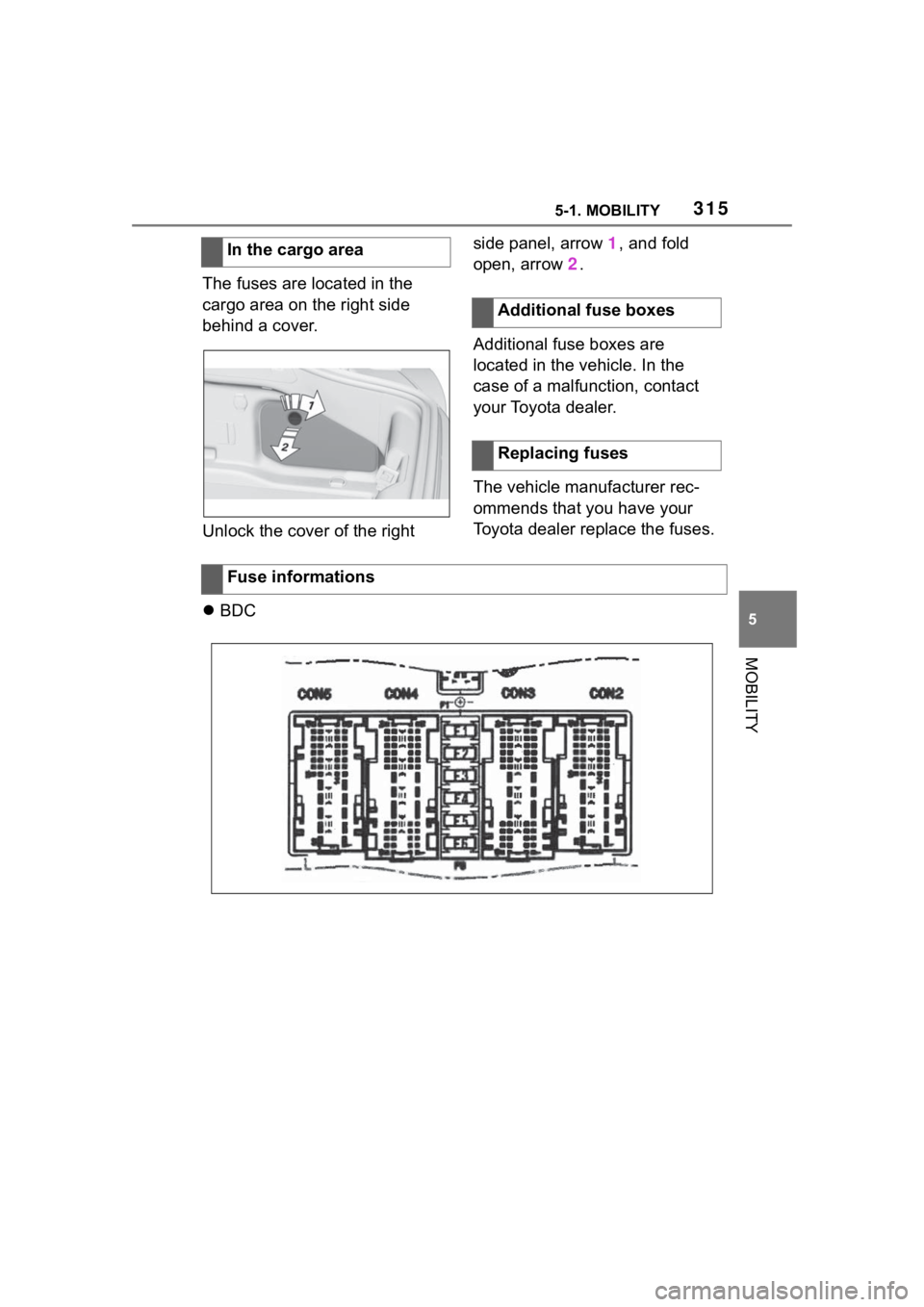2023 TOYOTA SUPRA lock
[x] Cancel search: lockPage 299 of 372

2995-1. MOBILITY
5
MOBILITY
1Pull lever, arrow 1.
Hood is unlocked.
2After the lever is released,
pull the lever again, arrow 2.
Hood can be opened.
3Be careful of protruding parts
on the hood.
Energetically close the hood
from approx. 20 in/50 cm.
The hood must engage on both
sides.
WARNING
There are protruding parts, for
instance locking hook, on the
inside of the hood. There is a risk
of injury. If the hood is open, pay
attention to protruding parts and
keep clear of these areas.
WARNING
An incorrectly locked hood can
open while driving and restrict vis-
ibility. There is a risk of an acci-
dent. Stop immediately and
correctly close the hood.
WARNING
Body parts can be jammed when
opening and closing the hood.
There is a risk of injury. Make sure
that the area of movement of the
hood is clear during opening and
closing.
NOTICE
Folded-away wipers can be
jammed when the hood is
opened. There is a risk of damage
to property. Make sure that the
wipers with the wiper blades
mounted are folded down onto the
windshield before opening the
hood.
Opening
Closing
Page 304 of 372

3045-1. MOBILITY
The oil filler neck is located in
the engine compartment, refer
to page 298.
1Open the hood, refer to page
299. 2
Open the lid counterclock-
wise.
3 Add engine oil.
4 Close the cap.
The engine oil quality is critical
for the life of the engine.
Only add the types of engine oil
which are listed.
Safety information
WARNING
Operating material
s, for instance
oils, greases, coolants, fuels, can
contain harmful ingredients.
There is a risk o f injuries or dan-
ger to life. Follow the instructions
on the containers. Avoid the con-
tact of articles of clothing, skin or
eyes with operating materials. Do
not refill operating materials into
different bottles. Store operating
materials out of reach of children.
NOTICE
An engine oil level that is too low
causes engine damage. There is
a risk of damage to property.
Immediately add engine oil.
NOTICE
Too much engine oil can damage
the engine or the catalytic con-
verter. There is a risk of damage
to property. Do not add too much
engine oil. When too much engine
oil is added, have the engine oil
level corrected by your Toyota
dealer.
Overview
Adding engine oil
Engine oil types to add
General information
Safety information
NOTICE
Oil additives can damage the
engine. There is a risk of damage
to property. Do not use oil addi-
tives.
NOTICE
Incorrect engine oil can cause
malfunctions in the engine or
damage it. There is a risk of dam-
age to property. When selecting
an engine oil, make sure that the
engine oil has the correct oil rat-
ing.
Page 306 of 372

3065-1. MOBILITY
mercially available additives are
suitable for the vehicle. The
vehicle manufacturer recom-
mends using coolant with the
BMW LC-18 specification. Do
not mix additives of different col-
ors. Observe the water - additive
mixture ratio of 50:50. Informa-
tion about suitable additives is
available from your Toyota
dealer.
Depending on the motorization,
there are up to two coolant res-
ervoirs in the engine compart-
ment. Check and top up the
coolant levels on a regular
basis.The coolant may be overfilled in
the coolant reservoir when the
vehicle is delivered from the fac-
tory. The normal coolant level is
achieved by operating the vehi-
cle for a longer period.
The coolant level is indicated
using the maximum mark in the
filler neck of the coolant reser-
voir.
Additional information:
For an overview, refer to page
298.
1
Let the engine cool.
2 Open the hood, refer to page
299.
3 Turn the lid of the coolant
reservoir slightly counter-
clockwise to allow any
excess pressure to dissi-
pate, then open it.
4 Open the coolant reservoir
lid.
5 The coolant level is correct
when it is just below the max-
imum mark in the filler neck.
Safety information
WARNING
With the engine hot and the cool-
ing system open, coolant can
escape and lead to scalding.
There is a risk of injury. Only open
the cooling system with the
engine cooled down.
WARNING
Additives are harmful and incor-
rect additives can damage the
engine. There is a risk of injury
and risk of damage to property.
Do not allow additives to come
into contact with skin, eyes or arti-
cles of clothing. Use suitable addi-
tives only.
Coolant level
General information
Checking the coolant level
Page 307 of 372

3075-1. MOBILITY
5
MOBILITY
6Close the cap.
1 Let the engine cool.
2 Open the hood, refer to page
299.
3 Turn the lid of the coolant
reservoir slightly counter-
clockwise to allow any
excess pressure to dissi-
pate, then open it.
4 Open the coolant reservoir
lid.
5 If the coolant is low, slowly
add coolant up to the speci-
fied level; do not overfill.
6 Close the cap.
7 Have the cause of the cool-
ant loss eliminated as soon
as possible.
Comply with the relevant envi-
ronmental protection regulations
when disposing of coolant and
coolant additives.
All washer nozzles are supplied
from one reservoir.
Use a mixture of tap water and windshield washer concentrate.
If desired, a windshield washer
concentrate containing anti-
freeze can be used.
Recommended minimum fill
quantity:0.2 US gal/1 liter.
Adding
Disposal
Washer fluid
General information
Safety information
WARNING
Some antifreeze agents can con-
tain harmful substances and are
flammable. There i s a risk of fire
and a risk of inj ury. Follow the
instructions on the containers.
Keep antifreeze away from igni-
tion sources. Do no t refill operat-
ing materials into different bottles.
Store operating materials out of
reach of children.
United States: th e washer fluid
mixture ratio is regulated by the
U.S. EPA and many individual
states; do not exceed the allow-
able washer fluid dilution ratio lim-
its that apply. Follow the usage
instructions on th e washer fluid
container.
WARNING
Washer fluid can ignite and catch
fire on contact with hot engine
parts. There is a risk of injury or
risk of damage to property. Only
add washer fluid when the engine
is cooled down. Next, fully close
the lid of the washer fluid reser-
v oi r.
Page 309 of 372

3095-1. MOBILITY
5
MOBILITY
Condition Based Service CBS
determines the maintenance
recommendation using sensors
and special algorithms that take
into account the driving condi-
tions of the vehicle.
The system makes it possible to
adapt the amount of mainte-
nance corresponding to your
user profile.
Information on service notifica-
tions, refer to page 147, can be
displayed on the Control Dis-
play.
Storage periods during which
the vehicle battery was discon-
nected are not taken into
account.
If this occurs, have a Toyota
dealer update the time-depen-
dent maintenance procedures,
such as checking brake fluid
and, if necessary, changing the
engine oil and the microfil-
ter/activated-charcoal filter.Please consult “Owner's War-
ranty Information Booklet” or
“Owner's Manual Supplement”
for additional information on ser-
vice and maintenance work.
The manufacturer of your vehi-
cle recommends that mainte-
nance and repair be performed
by a Toyota dealer. Records of
regular maintenance and repair
work should be retained.
Scheduled maintenance should
be performed at specified inter-
vals according to the mainte-
nance schedule.
For details about maintenance
items and schedules, refer to
the "Scheduled Maintenance
Guide" or "Owner's Manual Sup-
plement".
Devices connected to the OBD
socket trigger the alarm system
when the vehicle is locked.
Remove any devices con-
nected at the OBD socket
Condition Based Service
CBS
Concept
General information
Storage periods
"Owner's Warranty Infor-
mation Booklet" or
"Owner's Manual Supple-
ment"
Scheduled maintenance
Socket for OBD Onboard
Diagnosis
General information
Page 310 of 372

3105-1. MOBILITY
before locking the vehicle.
There is an OBD socket on the
driver's side for checking the pri-
mary components in the vehi-
cle's emissions.Safety information
NOTICE
The socket for Onboard Diagno-
sis is an intricate component
intended to be used in conjunction
with specialized equipment to
check the vehicle’s primary emis-
sions system. Improper use of the
socket for Onboard Diagnosis, or
contact with the socket for
Onboard Diagnosis for other than
its intended purpose, can cause
vehicle malfunctions and creates
risks of personal and property
damage. Given the foregoing, the
manufacture of your vehicle
strongly recommends that access
to the socket for Onboard Diagno-
sis be limited to your Toyota
dealer or other persons that have
the specialized
training and
equipment for purposes of prop-
erly utilizing the socket for
Onboard Diagnosis.
Position
Emissions
• The warning light
lights up:
Emissions are deterio-
rating. Have the vehi-
cle checked as soon
as possible.
• The warning light flashes under certain
circumstances:
This indicates that
there is excessive mis-
firing in the engine.
Reduce the vehicle
speed and have the
system checked imme-
diately; otherwise, seri-
ous engine misfiring
within a brief period
can seriously damage
emission control com-
ponents, in particular
the catalytic converter.
Page 311 of 372

3115-1. MOBILITY
5
MOBILITY
This chapter describes all stan-
dard, country-specific and
optional features offered with
the series. It also describes fea-
tures and functions that are not
necessarily available in your
vehicle, e.g., due to the selected
options or country versions. This
also applies to safety-related
functions and systems. When
using these functions and sys-
tems, the applicable laws and
regulations must be observed.
The onboard vehicle tool kit is
located under a cover on the
right side of the cargo area.
Unlock the cover of the right
side panel, arrow 1, and fold
open, arrow 2. 1
To change the wiper blades,
fold up the wiper arms, refer
to page 129.
2 Stop the vehicle.
Replacing components
Vehicle features and
options
Onboard vehicle tool kit
Wiper blades
Safety information
NOTICE
The window may sustain damage
if the wiper falls onto it without the
wiper blade installed. There is a
risk of damage to property. Hold
the wiper firmly when changing
the wiper blade. Do not fold or
switch on the wiper without a
wiper blade installed.
NOTICE
Folded-away wipers can be
jammed when the hood is
opened. There is a risk of damage
to property. Make sure that the
wipers with the wiper blades
mounted are folded down onto the
windshield before opening the
hood.
NOTICE
When replacing the wiper blades,
perform the procedure quickly
and do not leave the wiper arms
lifted without the w iper blades for
longer than necessary.
Replacing the front wiper
blades
Page 315 of 372

3155-1. MOBILITY
5
MOBILITY
The fuses are located in the
cargo area on the right side
behind a cover.
Unlock the cover of the right side panel, arrow
1, and fold
open, arrow 2.
Additional fuse boxes are
located in the vehicle. In the
case of a malfunction, contact
your Toyota dealer.
The vehicle manufacturer rec-
ommends that you have your
Toyota dealer replace the fuses.
BDCIn the cargo area
Additional fuse boxes
Replacing fuses
Fuse informations